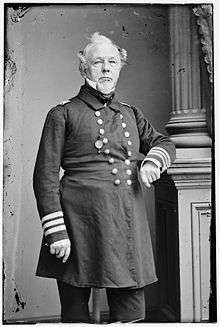John B. Montgomery
| John Berrien Montgomery | |
|---|---|
 | |
| Born |
1794 Allentown, New Jersey |
| Died |
March 25, 1872 Carlisle, Pennsylvania |
| Place of burial |
Oak Hill Cemetery Washington, D.C. |
| Allegiance |
|
| Service/branch |
|
| Years of service | 1812–1869 |
| Rank |
|
| Commands held |
USS Portsmouth USS Roanoke Pacific Squadron |
| Battles/wars |
Mexican–American War American Civil War |
John Berrien Montgomery (1794 – 25 March 1872) was an officer in the United States Navy who served during the Mexican-American War and the American Civil War.
Biography
Montgomery was born in Allentown, New Jersey. He entered the Navy as a midshipman in 1812; served in the attack on Kingston, Canada, in November of the same year, and in the capture of York in April of the following year; and for gallantly on board the Niagara in Perry's victory on Lake Erie, September 10, 1813, received a vote of thanks and a sword from Congress. In 1815 he served in Decatur's squadron in the war with Algiers, was made a lieutenant in 1818, and commander in 1839.[1]
His commands included the sloop-of-war Portsmouth in 1844, and the steam frigate Roanoke in 1857. He served as Commandant of the Boston Navy Yard from June 1862 to December 1863, and then of the Washington Navy Yard in 1865.
During the Mexican-American War, in early June 1846, Montgomery and the ship he commanded, the USS Portsmouth, arrived in San Francisco Bay, then part of Mexican Alta California. As a result, Montgomery was involved, albeit as a witness only, in the events of the Bear Flag Revolt in which foreign residents, mostly American, revolted against the Mexican authorities. As a naval representative of the U.S. Government, he was deferred to by representatives of the Revolt, by representatives of the Alta California government and by other representatives of the U.S. On June 16, 1846, Montgomery sent a mission to Sonoma to investigate the conditions there, following the Revolt.
On July 9, 1846, Montgomery and his detachment from the Portsmouth raised the American flag over the plaza in the town of Yerba Buena (today's San Francisco). The name of the plaza was later changed to Portsmouth Square, commemorating Montgomery's ship. At his direction, Lt. Joseph W. Revere also lowered the Bear Flag flying at Sonoma, California, north of San Francisco Bay and raised the U.S. Flag. The lowered Bear Flag ended up in Montgomery's possession and, in 1848, he delivered it to Naval authorities in Boston. Ultimately, in 1855, the flag was returned to California, where it was destroyed in the fires caused by the 1906 earthquake.
In other action of the Mexican-American War, Montgomery blockaded Mazatlan for some months, and, with the assistance of Captain Lavalette in the Congress, captured Guaymas. He was made a captain in 1853.[1] In 1859, Montgomery commanded the Pacific Squadron until relieved on January 2, 1862.
Montgomery died at Carlisle, Pennsylvania in March 1872. His remains were interred at Oak Hill Cemetery, Washington, D.C.
Namesakes
Montgomery Street, a notable street in downtown San Francisco, is named for him.[2]
Notes
- 1 2
 This article incorporates text from a publication now in the public domain: Gilman, D. C.; Thurston, H. T.; Colby, F. M., eds. (1905). "Montgomery, John Berrien". New International Encyclopedia (1st ed.). New York: Dodd, Mead.
This article incorporates text from a publication now in the public domain: Gilman, D. C.; Thurston, H. T.; Colby, F. M., eds. (1905). "Montgomery, John Berrien". New International Encyclopedia (1st ed.). New York: Dodd, Mead. - ↑ San Francisco Streets Named for Pioneers: G-M, accessed August 29, 2006
References
- Rogers, Fred Blackburn, Montgomery and the Portsmouth (The Portsmouth Marine Society, 1990).